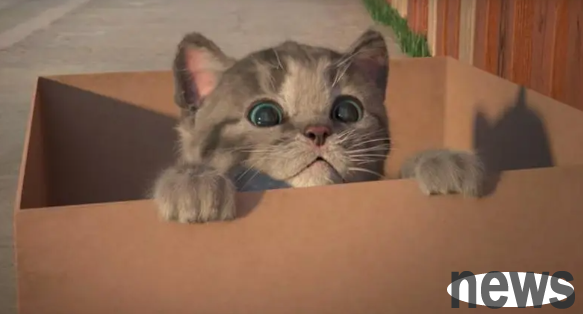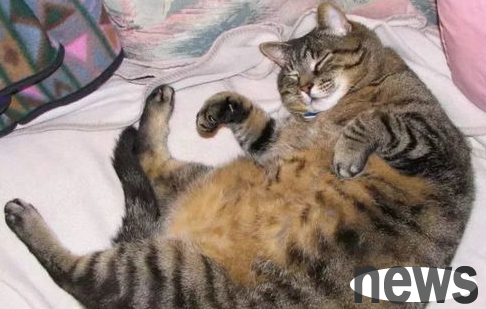The liver is one of the most vulnerable organs of cats. It can filter toxins, but overloaded toxins can cause liver failure. Some pets are genetically prone to liver failure, and vitamin deficiency can cause liver dysfunction in other animals, especially cats. Bacterial or viral infections in the liver can also cause this vital organ to stop working.

Fat fatty liver syndrome/Cat hepatic lipid deposition:
The most common reason is that the cat does not eat for a long time, causing the liver to start digesting stored fat, and some of the undiluted fat is trapped in the liver; if the ears, gums and other parts are found to be yellow, you need to pay great attention and take it to the hospital in time. Fatty liver ranks first among cats' liver diseases. If you don't seek medical treatment in time after you get it, it will be a dead end.
Why do cats get fatty liver? It may be different from what you think
· Sudden weight loss
· Depressed appetite
· Depressed mentality
· Vomiting, diarrhea/constipation (alternating)
· Swelling of the liver (no obvious pain when touched)
· Excessive drooling
· Abnormal behavior
· Muscle atrophy
· Anemia
· Jaundice (yellow eyes, often occur in the later stages of the disease)
Note: Some medical studies have shown that cats of any grade have the chance of illness, among which elderly and middle-aged cats have the highest chance of illness, especially female and obese cats. The cat's eyes in the picture are yellowed. The initial weight loss and appetite decreases. After we change our diet, the cat will try to eat. I have to say that we breathed a sigh of relief. But at this time, the cat's liver has been affected, and then it will reduce its eating. When we find something is wrong, the cat has symptoms of jaundice. The result of the continued deterioration is that cats have problems with their blood coagulation ability, and minor bumps will cause bruises. Even cats with severe liver disease will also have skin fragility syndrome, resulting in skin scarring.
The early symptoms of fatty liver are almost the same as those of cats swallowing hairballs or foreign objects. Only changes in behavior indicate physical discomfort. Therefore, parents must be alert to any changes in the cat, or even subtle changes in their daily interactions. Once something is found, please send them to the hospital for disease testing immediately.
Note: If an obese cat has experienced sudden loss of appetite and rapid loss of weight, you also need to be vigilant.
Diagnosis method:
· Biochemical index
Helectron enzyme SAP and bilirubin are significantly increased, high cholesterol and bile acid abnormalities, and coagulation ability is reduced.
· X-ray
The liver is normal/enlarged.
· Ultrasound
can see typical changes in the liver, and other causes such as other diseases (such as liver lymphoma, liver abscess, etc.) and laboratory abnormalities.
· Biopsy
is aspirated by a fine needle of liver puncture biopsy.
· Urine test
shows an increase in urine ketone, but it is worth noting that diabetes also increases urine ketone.
Causes of fatty liver syndrome:
1. Primary
· Long-term intake of high fat and high carbohydrates
· Foods with low protein
· Hunger
· Inadequate exercise
· Insufficient anti-fat substances
· Stress response (environment/diet changes, addition of new members, long-distance transportation, etc.)
2. Inducible
· Choleduct hepatitis
· Pancreatitis
· Diabetes
· Inflammatory bowel disease
· Cancer
· Parasitic disease
· Other infectious diseases:
Treatment methods:
Because cats with fatty liver want to survive, they must ensure full eating. Of course, this is not to question the parents, but forcibly feeding will cause many cats to resist and hurt you by mistake, and it is easy to cause great psychological pressure to the cats, causing the cats to become more and more resistant to eating. If you ask a professional doctor to handle it on your behalf (such as feeding a feeding tube), you will recover many of them, and there are many diseases that are somewhat similar to fatty liver, which need to be ruled out by the hospital, and other potential diseases can also be treated together to save you unnecessary trouble.
· Nasofeeding tube
is inserted into the stomach through the side of the cat and enters the stomach (or esophagus) through the nose. The size/type of the feeding tube depends on the size and severity of the cat, and whether it can support the placement surgery for nasofeeding tube.
Note: Food intake is an important step in determining whether a cat can survive successfully. Although nasofesting tubes are uncomfortable, they are more stressful and have higher efficiency than syringes.
· Feeding accelerator
, such as diazepam, but is suitable for cats who still have an appetite and interest in food; mirtazapine is a popular appetite promoter in recent years. It is a human psychiatric drug. Low doses of use will have a strong appetite enhancement effect (but some cats have no effect after taking it, and it is not certain why.)
· Replenishing fluids and electrolytes
Most cats with fatty liver will be dehydrated. If the cats have obvious vomiting, their potassium levels in their blood are usually very low.
· Vitamin
Cats with hepatic fat liver need vitamin K supplementation to help the liver create factors that help blood clotting; long-term anorexia can supplement thiamine; in addition, the intake of cannedin can enhance fat metabolism and is widely used.
· Gastrointestinal drugs
such as cimetidine, ranitidine, etc. can prevent gastric and intestinal ulcers; metoclopramide can reduce vomiting and stimulate food to move through the stomach and intestinal tract.
· For the treatment of hepatic encephalopathy
, drugs such as neomycin or metronidazole can be used.
· Antibiotics
To prevent secondary infections or curb existing infections, some antibiotics can be used.
Note: The process of treating fatty liver is relatively long in accordance with the doctor's instructions, and the diet is extremely high. During the treatment period, you need to feed a nutritional, high-protein, easy-to-digestible diet, and eat less and more meals. The same old saying is the above, and the above is for reference only. The specific treatment plan is determined by the doctor's test and the severity of the disease. Professional matters should be left to professionals.

Prevent and prevent recurrence:
· Avoid excessive intake of starch and high-fat foods
· If cats are already in a tendency to obesity, it is recommended to go to the hospital for a physical examination
· More exercise (play), appropriately reduce intake
· Fed feeding, and eat less and more meals
Note: Be sure to pay attention to the low-quality commercial food without brands, these products are one of the potential causes of many inflammatory diseases. This includes chronic hepatitis, chronic pancreatitis, inflammatory enteritis, cholecystitis and other diseases that occur in pet cats, and the same is true for fatty liver. The ratio and raw material quality of products such as cat food are based on economic considerations and are based on the industrial feed standard AAFCO. The starting point does not include the long-term and overall health of cats. (The text is captured in Dr. Ron Hines's article "Hepatic Lipidosis Why It Occurs, How Vets Treat It, How To Prevent It")
Warm tips: During the treatment period, the cat can gradually restore the habit of eating independently, and give the cat a taste of food it usually likes (at this time it eats whatever it wants), try to heat the cat to stimulate a strong fragrance, and cat to its feeding method (such as eating in a familiar place, but requires the consent of the doctor).
Daga is good, National Day seven days of joy, push is changed to 1, 4, and 7 days, and a bunch of cats are prepared for everyone to suck enough for Daga~~~